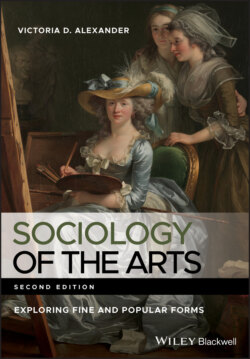Читать книгу Sociology of the Arts - Victoria D. Alexander - Страница 44
Mass Culture Theorists
ОглавлениеThe ideas sowed by Arnold in the 1860s bloomed into the theories of cultural highbrows in the 1930s and beyond. These authors believed that as much as high art was beneficial, mass art was harmful. By this time, the concept of “high culture,” especially in its contrast to popular culture, had become firmly institutionalized (the distinction was not as sharply drawn in the nineteenth century, as we shall see in Chapter 12). While intellectuals still sung the praises of fine art, they now worried, in addition, about the deleterious effects of the popular arts. For instance, Q.D. Leavis (1978 [1932]) was concerned that the masses were rejecting the great books chosen for remembrance by intellectuals and professors, who know best, and were instead reading popular fiction, to the detriment of themselves and society. Leavis believed that consuming pulp fiction was like a drug addiction. She was also concerned about the harmful effects of Hollywood movies and advertising. This literature marks the shift from an emphasis on the uplifting effects of fine arts to the “cultural critique” of the mass arts.
A number of theorists writing in the 1950s developed a specific critique of mass culture, relating the rise of mass culture to changes wrought by the industrialization of society. These writers focused on the broadly distributed popular arts (especially television, but also popular music, fiction, and movies), arguing that this “mass culture” is standardized, homogeneous, and puerile in its appeal to the lowest common denominator, implicitly suggesting that it is consumed by an undifferentiated, passive, mass audience.
These authors make firm distinctions among types of art:
Folk art grew from below. It was a spontaneous, autochthonous expression of the people, shaped by themselves, pretty much without the benefit of High Culture, to suit their own needs. Mass culture is imposed from above. It is fabricated by technicians hired by businessmen; its audiences are passive consumers, their participation limited to the choice between buying and not buying… Folk art was the people’s own institution, their private little garden walled off from the great formal park of their masters’ High Culture. But Mass Culture breaks down the wall, integrating the masses into a debased form of High Culture and thus becoming an instrument of political domination. (MacDonald, 1957: 60)
They suggest that mass culture is “parasitic” in that it feeds off ideas generated by the fine arts, without returning a single new thought to them. At the same time, they argue, mass culture strangles folk culture and displaces it. They develop from this analysis a “Gresham’s Law” of culture—the bad drives out the good—whereby mass culture replaces the fine arts and the folk arts. Further, the mass audience spends too much time on unedifying mass art, and in consequence spends less time on useful, educational and productive pursuits. Moreover, beyond filling time, mass culture actively harms those who consume it by inculcating in them a passivity that erodes their critical faculties and makes them prone to manipulation and exploitation.
The similarities of the mass culture critique and the Frankfurt School are evident, especially in their analysis of its pernicious effects, but there are important differences. Writers from the Frankfurt School agreed with the mass culture critics that mass culture was dangerous, but not because it undermined the cultural authority of intellectuals. They worried about almost exactly the reverse. They argued that mass culture strengthened the hand of the elites. Leavis, for instance, thought that the masses had become strong enough to “outvote” intellectuals on the merits of popular versus “quality” fiction. The Frankfurt School, on the other hand, saw the masses as powerless and the cultural industries as all powerful.
